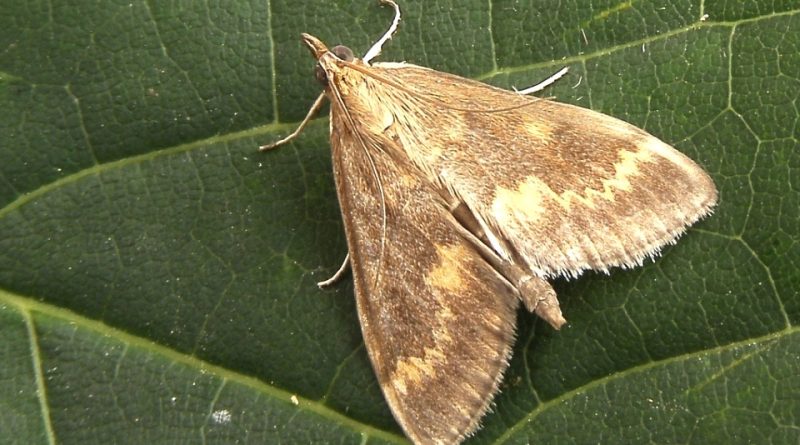Ostrinia nubilalis
Ostrinia nubilalis
The corn borer (Ostrinia nubilalis (Hübner, 1796)), is a lepidopter insect belonging to the Crambidae family.
Systematics –
From a systematic point of view it belongs to the Eukaryota Domain, Kingdom Animalia, Eumetazoa Sub-estate, Superphylum Protostomia, Phylum Arthropoda, Subphylum Tracheata, Superclass Hexapoda, Class Insecta, Subclass Pterygota, Coop Endopterygota, Superorder Oligoneoptera, Section Panorpoidea, Order Lepidoptera, Suborder Glossata, Infraorder Heteroneura, Ditrysia Division, Pyraloidea Superfamily, Crambidae Family, Subfamily Pyraustinae, Pyraustini Tribe and then the Ostrinia Genus and O. Nubilated Species.
Geographic Distribution and Habitat –
Ostrinia nubilalis is a lepidopter attacking a variety of cereals and other crops in North America, Europe and North Africa; in Italy this insect is widespread above all in the northern and central Italian regions.
Morphology –
The corn borer is a medium-sized butterfly, with a wingspan of about 25-30 mm; it has a sexual dimorphism because the male is smaller than the female. The front wings of this butterfly are yellowish, with darker variegations in the male and less evident in the female; the hind wings are uniform and have a cream color, in females the color tone is lighter. The larva measures about 20-25 mm in length and has a grayish or hazelnut livery, with longitudinal bands, a median and two lateral, tending to green, with rows of dark tubercles. The head and the prothorax are dark brown.
Attitude and biological cycle –
The Ostrinia nubilalis winters at the larva stage, maturing inside the poles and at the culm, especially in the basal part, and then incisalally in the spring period. The first adults then perform in the final period of May (early in the hottest regions) and the flicker continues throughout the following month until the beginning of July. The adults have nocturnal habits, with the females laying on the lower page of the leaves and on the culms the eggs in whitish plaque ovations. On average, in each ovum there are about ten eggs. The larvae born from these depositions (1st generation) attack the leaf sheaths, the leaves and enter the culm, where, when they reach maturity, they become incisal. The adults of the 2nd flight flicker from the second half of July until the beginning of September. The oviposition usually takes place at the base of the bracts of the ear. The larvae coming from this generation (2 ^) attack mainly the spikes, nibbling the kernels; then they penetrate into the tutulus and partly into the culm, pushing to the base, where they spend the winter. In this way the Piralide takes two generations a year.
In the ecosystem of the Po Valley there are two Piralide breeds: one with only one generation and the other with two generations a year: they are called monovoltina and bivoltina respectively.
In the past years the fight against Ostrinia nubilalis was made obligatory with the D.M. of 12/06/1950 (which was subsequently repealed by the Ministerial Decree of 17 April 1998); the fight required the landfill, destruction or debrisage of the stalks and of the stalks before April 15th in order to eliminate the larvae during the wintering phase. The interventions to contain this insect can be agronomic, biological and chemical. Obviously the cultivation conditions and the agronomic systems adopted, especially for the cultivation of the Corn, require chemical interventions that, in fact, become, from the ecological point of view, a very dangerous boomerang. In order to reduce the presence of this moth, completely different corn cultivation criteria, different rotation and association techniques and non-chemical fertilizing systems should be used.
In the chemical fight only intervenes in case of exceeding the threshold, which depends on the plant attached (eg sweet corn, seed corn, or pepper) by products allowed by the integrated pest control, while if it is corn or grain silo does not need to intervene with insecticides that could create problems with the onset of the red spider. Or you can also perform monitoring, that is, the use of pheromone-specific pheromone traps with pheromone and PAA food attraction.
The biological fight mainly involves the use of preparations based on Bacillus thuringiensis, ssp. kurstaki; or the introduction of the parasitoid ointment or Trichogramma brassicae hymenoptera that can be launched in open field with airplanes or drones.
Outside the country, resistant (Bt-corn or Bt-corn) seeds are used, in the genome of which there is a Bacillus thuringiensis gene that allows the plant to produce a particular toxin; this toxin is active only in the gastrointestinal tract of some insects, among which the order of the Lepidoptera, killing the Ostrinia caterpillars which, feeding on the tissues of the transgenic plant, ingest also the toxin.
Ecological role –
Ostrinia nubilalis is considered one of the main phytophagous maize, in Italy it is widespread above all in the northern and central regions, where it attacks maize, sorghum and various vegetable crops, in particular the pepper, and ornamental flowers. The main damages, caused by the larvae, occur on the leaves, on the culms and on the kernels. The larvae attack the young leaves still rolled up, which are thus pierced, penetrate the culm, digging deep tunnels that weaken the plant, so that, in some cases, the culm can break due to the action of the wind. To identify the presence of the insect on the surface of the culm you can see numerous holes for entry / exit of the larvae that carry out their trophic action. In a second moment, the second generation larvae feed on both the ear and the kernels, with a consequent decrease in production. The interested plants
The corn borer is a polyphagous species; the plants concerned are: Corn and other Gramineae, Pepper, Bean, Asparagus, Tomato, Chard, Sunflower, Tobacco, Ornamental (Gladiolus, Chrysanthemums, etc.), Arboree (branches of Poplar, Peach, fruits of Apple and Actinidia).
Guido Bissanti
Sources
– Wikipedia, the free encyclopedia.
– Russo G., 1976. Agricultural Entomology. Special Part. Liguori Editore, Naples.
– Tremblay E., 1997. Applied entomology. Liguori Editore, Naples.

